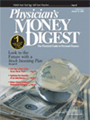Publication
Article
Physician's Money Digest
Understand the Effects of Time on Bonds
Author(s):
Between April 1, 2000, and March 31, 2003,the Dow, Nasdaq, and S&P 500 had cumulativereturns of -22.6%, -70.5%, and -40.8%,respectively. On the other hand, the LehmanBrothers' Aggregate Bond Index had a cumulativereturn of +32.4% during this period. Consequently,many investors lost faith in the stock market. A numberof factors contributed to the market's worstdecline in seventy years, including terrorism, corporateimpropriety, and war.
After realizing tremendous losses in their retirementand savings plans, many investors headed forthe bond market. If you had the foresight to see whatwas coming down the pike and moved all of yourmoney into a bond fund whose performance mirroredthat of the Lehman Brothers' Aggregate Bond Index,you would have preserved your capital and realizednearly a 10% annual rate of return during that 3-yearperiod. Of course, hindsight is 20/20.
Interest Rate Impact
Eventually, Alan Greenspan lowered interest ratesin an attempt to spur economic growth by reducingthe cost of corporate borrowing, raising corporateprofits, and ultimately raising stock prices. This hashad a positive impact on the stock market. Right now,interest rates have nowhere to go but up (they've beenat a record 40-year low for the past year). This willhave a dramatic impact on bond prices, especiallybonds that have longer terms to maturity.
The following example illustrates the impact ofrising interest rates on bond prices. Suppose Dr. Smithpurchased $100,000 of 30-year bonds in ABCCorporation, which produces $7000 in annual interestincome. This bond issue has 15 years left until itmatures and currently yields 7%. Dr. Smith also purchased$100,000 of 30-year bonds in XYZCorporation, which produces $6000 annually ininterest income. This bond issue has 5 years left untilit matures and currently yields 6%. Both companieshave the same credit risk.
If interest rates increase by 1% between now andnext year and the yield on both ABC and XYZ bondsincrease by 1%, ABC Corporation's bonds will beworth approximately $91,450. The bonds of XYZCorporation will be worth approximately $95,900. Inother words, ABC Corporation's bonds will decline invalue by about $8450 or 8.55%, while XYZCorporation's bonds will decline in value by only$4100 or 4.10%. As you can see, the value of a long-termbond is much more volatile than the value of ashort-term bond.
Fixed-Income Reality
As a physician-investor, you may be spooked bythe stock market and think that by moving your assetsinto fixed-income investments you'll insulate yourportfolio from the risk of loss. That's not necessarilythe case. Additionally, don't fall into the trap of beingdriven by greed. If you think that obtaining a higheryield on long-term fixed-income instruments is betterthan sacrificing yield on short-term fixed-incomeinvestments, you could be making a big mistake.
Note:
If you're income-oriented, afraid of the risk inherentin the stock market, and think that interest ratesmay soon be going up (rates will probably not riseuntil late 2004), you might want to consider the bondmarket. If you do decide to pursue the bondmarket, make sure that you keep your money in short-termfixed-income investments that are investment-gradequality.
Thomas R. Kosky and his partner, Harris L.Kerker, are principals of the Asset PlanningGroup, Inc, in Miami, Fla. The company specializesin investment, retirement, and estate planning.Mr. Kosky also teaches corporate finance inthe Saturday Executive and Health CareExecutive MBA Programs at the University ofMiami in Coral Gables, Fla. They welcome questions or comments at800-953-5508, or visit www.assetplanning.net.
